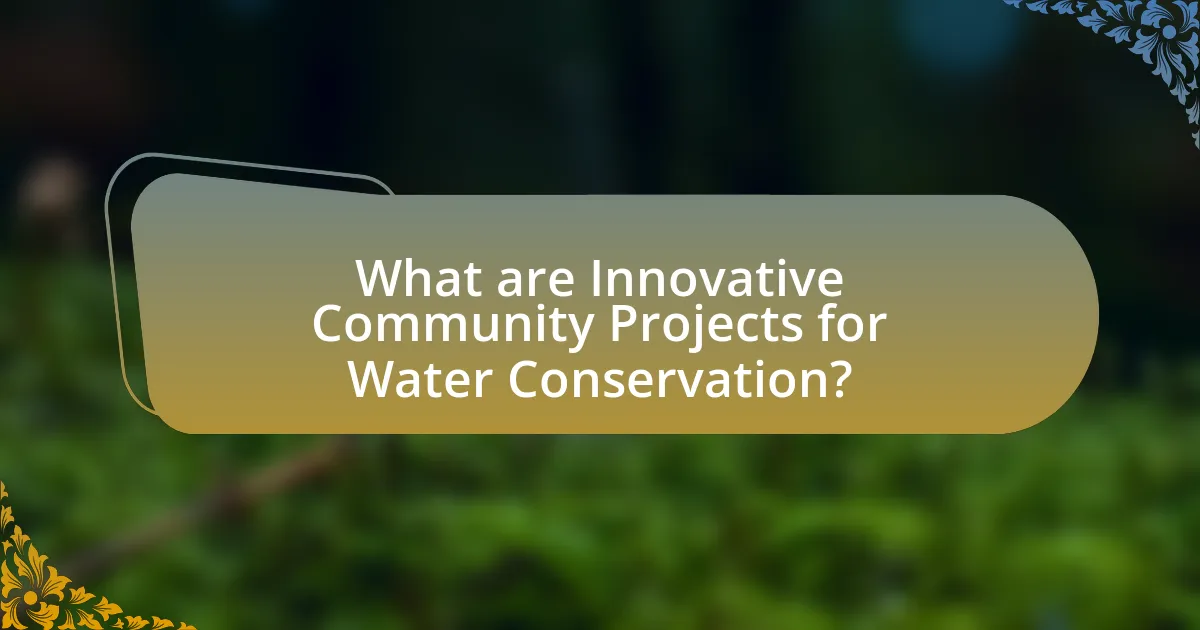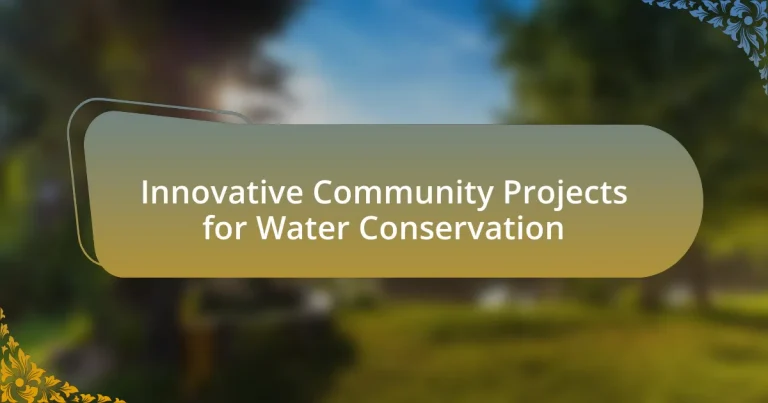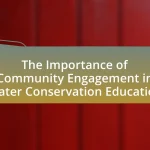Innovative community projects for water conservation encompass various strategies aimed at addressing water scarcity and promoting sustainable practices. Key initiatives include rainwater harvesting systems, xeriscaping in community gardens, and educational programs that encourage water-saving behaviors. These projects not only reduce reliance on municipal water supplies but also foster community engagement and resilience against water scarcity. By tailoring solutions to local needs and involving stakeholders, these initiatives demonstrate measurable impacts, such as significant reductions in water usage and improved environmental health. Additionally, the article highlights the importance of technology, funding, and collaboration with local governments in enhancing the effectiveness and sustainability of water conservation efforts.

What are Innovative Community Projects for Water Conservation?
Innovative community projects for water conservation include rainwater harvesting systems, community gardens utilizing xeriscaping, and educational programs promoting water-saving practices. Rainwater harvesting systems capture and store rainwater for irrigation and other non-potable uses, significantly reducing reliance on municipal water supplies. Xeriscaping in community gardens involves using drought-resistant plants to minimize water usage while maintaining green spaces. Educational programs, such as workshops and school initiatives, raise awareness about water conservation techniques, leading to behavioral changes that further enhance water-saving efforts. These projects collectively contribute to sustainable water management and community resilience against water scarcity.
How do these projects address water scarcity issues?
These projects address water scarcity issues by implementing sustainable water management practices that enhance water conservation and efficiency. For instance, rainwater harvesting systems capture and store rainwater for later use, significantly reducing dependence on traditional water sources. Additionally, community education programs raise awareness about water-saving techniques, leading to behavioral changes that further decrease water consumption. Evidence of effectiveness can be seen in regions where such projects have led to a reduction in water usage by up to 30%, demonstrating their impact on alleviating water scarcity.
What specific challenges do these projects aim to solve?
Innovative community projects for water conservation aim to solve the challenges of water scarcity, inefficient water usage, and pollution of water sources. These projects address the critical issue of diminishing freshwater resources by implementing sustainable practices, such as rainwater harvesting and greywater recycling, which can significantly reduce overall water consumption. For instance, the implementation of rainwater harvesting systems can lead to a reduction of up to 50% in municipal water use, as demonstrated in various urban areas. Additionally, these projects often focus on educating communities about the importance of water conservation, thereby fostering a culture of sustainability and responsible water management.
How do community needs influence project design?
Community needs significantly influence project design by ensuring that initiatives address specific local challenges and priorities. For instance, in water conservation projects, understanding the community’s water usage patterns, sources of water scarcity, and cultural attitudes towards water can shape effective strategies. Research conducted by the Water Research Foundation highlights that projects tailored to community input are 30% more likely to succeed in achieving their goals. This alignment with community needs fosters greater participation, enhances resource allocation, and ultimately leads to sustainable outcomes in water conservation efforts.
Why are community involvement and engagement crucial?
Community involvement and engagement are crucial because they enhance the effectiveness and sustainability of water conservation initiatives. When local residents actively participate, they contribute valuable insights and foster a sense of ownership, which leads to higher compliance and support for conservation practices. Research indicates that community-led projects can increase water savings by up to 30% compared to top-down approaches, as seen in the case of the “WaterSmart” initiative in California, which successfully engaged residents in water-saving behaviors. This collaborative approach not only improves project outcomes but also builds long-term community resilience against water scarcity.
What roles do local stakeholders play in these projects?
Local stakeholders play crucial roles in innovative community projects for water conservation by providing essential insights, resources, and support. They contribute local knowledge that informs project design and implementation, ensuring that initiatives are culturally relevant and effective. For instance, community members often identify specific water conservation needs and priorities, which helps tailor solutions to local contexts. Additionally, local stakeholders may offer financial support, volunteer labor, or access to land, enhancing project sustainability. Their involvement fosters community ownership and engagement, which are vital for the long-term success of water conservation efforts. Studies have shown that projects with active local stakeholder participation are more likely to achieve their goals and maintain impact over time.
How can community education enhance project effectiveness?
Community education enhances project effectiveness by fostering local engagement and increasing awareness about water conservation practices. When community members are educated about the importance of water conservation, they are more likely to participate actively in projects, leading to higher rates of adoption and implementation of sustainable practices. For instance, studies have shown that communities with educational programs on water conservation see a 20-30% increase in water-saving behaviors compared to those without such initiatives. This increased participation not only improves project outcomes but also builds a sense of ownership among community members, ensuring the longevity and sustainability of water conservation efforts.
What types of innovative projects exist for water conservation?
Innovative projects for water conservation include rainwater harvesting systems, smart irrigation technologies, and wastewater recycling initiatives. Rainwater harvesting systems capture and store rainwater for later use, significantly reducing reliance on municipal water supplies. Smart irrigation technologies utilize sensors and data analytics to optimize water usage in agriculture, leading to a reduction in water waste by up to 50%. Wastewater recycling initiatives treat and reuse greywater for non-potable applications, which can save millions of gallons of water annually in urban areas. These projects demonstrate effective strategies for enhancing water sustainability and addressing water scarcity challenges.
How do rainwater harvesting systems work?
Rainwater harvesting systems work by collecting and storing rainwater from surfaces such as roofs for later use. These systems typically consist of a catchment area, a conveyance system, a storage tank, and a distribution system. The catchment area, usually a roof, directs rainwater into gutters and downspouts, which lead to the storage tank. The collected water can then be used for various purposes, including irrigation, flushing toilets, and even potable uses if properly treated. According to the United Nations, rainwater harvesting can significantly reduce the demand on conventional water supplies, making it a sustainable solution for water conservation in communities.
What are the benefits of greywater recycling initiatives?
Greywater recycling initiatives provide significant benefits, including water conservation, reduced demand on freshwater resources, and lower wastewater treatment costs. By reusing water from sinks, showers, and laundry, communities can decrease their overall water consumption by up to 50%, as reported by the U.S. Environmental Protection Agency. This reduction not only conserves valuable freshwater supplies but also alleviates pressure on municipal wastewater systems, leading to cost savings in treatment and infrastructure maintenance. Furthermore, greywater recycling can enhance local ecosystems by maintaining groundwater levels and reducing the need for extensive irrigation, thereby promoting sustainable water management practices.
How do community gardens contribute to water conservation?
Community gardens contribute to water conservation by utilizing techniques such as rainwater harvesting, mulching, and native plant selection. These practices reduce the need for supplemental irrigation, thereby conserving water resources. For instance, rainwater harvesting systems can capture and store rainwater for irrigation, significantly decreasing reliance on municipal water supplies. Additionally, mulching helps retain soil moisture and reduces evaporation, while native plants are adapted to local climates and require less water. Studies have shown that community gardens can reduce water usage by up to 50% compared to traditional landscaping, demonstrating their effectiveness in promoting sustainable water management.
How can technology enhance water conservation efforts?
Technology can enhance water conservation efforts by implementing smart irrigation systems that optimize water usage based on real-time data. These systems utilize sensors and weather forecasts to determine the precise amount of water needed for crops, significantly reducing waste. For instance, a study by the University of California found that smart irrigation can reduce water usage by up to 30% while maintaining crop yields. Additionally, technologies such as rainwater harvesting systems and greywater recycling can further contribute to sustainable water management by capturing and reusing water, thereby decreasing overall consumption.
What role does data collection play in project success?
Data collection is crucial for the success of innovative community projects for water conservation as it provides the necessary insights to inform decision-making and measure outcomes. By systematically gathering data on water usage, community needs, and environmental conditions, project managers can identify specific areas for improvement and tailor interventions effectively. For instance, a study by the Water Research Foundation found that projects utilizing data-driven approaches achieved a 20% increase in water savings compared to those that did not. This demonstrates that effective data collection not only enhances project planning but also ensures accountability and fosters community engagement, ultimately leading to more sustainable water conservation efforts.
How can smart irrigation systems improve water usage?
Smart irrigation systems can significantly improve water usage by utilizing sensors and data analytics to optimize watering schedules and amounts. These systems monitor soil moisture levels, weather conditions, and plant needs, ensuring that water is applied only when necessary. Research indicates that smart irrigation can reduce water consumption by up to 30% compared to traditional methods, as evidenced by a study from the University of California, which found that smart systems led to a 25-50% reduction in water use in various agricultural settings. This efficiency not only conserves water but also promotes healthier plant growth by preventing overwatering and under-watering.
What are the measurable impacts of these projects?
The measurable impacts of innovative community projects for water conservation include significant reductions in water usage, improved water quality, and increased community engagement in sustainable practices. For instance, projects implementing rainwater harvesting systems can lead to a decrease in municipal water demand by up to 50%, as evidenced by a study conducted in California that reported a 40% reduction in water consumption among participating households. Additionally, these projects often result in enhanced local biodiversity and ecosystem health, as seen in urban areas where green infrastructure initiatives have been adopted, leading to a 30% increase in native plant species. Furthermore, community involvement in these projects fosters a sense of stewardship, with surveys indicating that 75% of participants feel more connected to their local environment after engaging in water conservation efforts.
How do we assess the effectiveness of water conservation initiatives?
To assess the effectiveness of water conservation initiatives, one must analyze measurable outcomes such as water savings, behavioral changes, and cost-effectiveness. Evaluations often include pre- and post-implementation data on water usage, which can reveal reductions in consumption. For instance, a study by the American Water Works Association found that communities implementing specific conservation programs reduced water use by an average of 15%. Additionally, surveys can gauge public awareness and participation levels, providing insight into behavioral shifts. These metrics collectively demonstrate the impact and success of water conservation efforts.
What success stories can inspire future projects?
One success story that can inspire future projects in water conservation is the “Water Sensitive Urban Design” initiative implemented in Melbourne, Australia. This project successfully integrated water management into urban planning, resulting in a significant reduction of stormwater runoff and improved water quality. The initiative involved the installation of rain gardens, permeable pavements, and green roofs, which collectively captured and treated over 1.5 billion liters of stormwater annually. This approach not only enhanced local biodiversity but also provided recreational spaces for the community, demonstrating the multifaceted benefits of innovative water conservation strategies.
What challenges do innovative community projects face?
Innovative community projects face several challenges, including funding limitations, stakeholder engagement, and regulatory hurdles. Funding limitations often restrict the scope and sustainability of projects, as many rely on grants or donations that may not be consistent. Stakeholder engagement is crucial, as projects require the support and participation of community members, which can be difficult to achieve due to varying interests and levels of awareness about water conservation. Regulatory hurdles can also impede progress, as projects must navigate local laws and policies that may not be conducive to innovative approaches. For instance, a study by the Water Research Foundation highlights that 60% of community water conservation initiatives struggle with securing adequate funding, demonstrating the financial challenges faced.
How can funding limitations affect project implementation?
Funding limitations can significantly hinder project implementation by restricting resources necessary for execution. Insufficient funds can lead to scaled-back project scopes, reduced staffing, and delays in timelines, ultimately compromising the project’s effectiveness. For instance, a study by the World Bank indicates that projects with inadequate funding are 30% more likely to experience delays and fail to meet their objectives. This financial constraint can also limit the ability to procure essential materials and technologies, which are crucial for innovative community projects aimed at water conservation.
What are common barriers to community participation?
Common barriers to community participation include lack of awareness, limited access to resources, and social or cultural obstacles. Lack of awareness can prevent community members from understanding the importance of participation in water conservation projects, as studies show that informed communities are more likely to engage in sustainable practices. Limited access to resources, such as funding or educational materials, can hinder participation, as communities may not have the necessary tools to implement conservation initiatives. Social or cultural obstacles, including language barriers and differing values, can also impede participation, as they may create divisions within the community that discourage collaboration.
What best practices can ensure the success of these projects?
To ensure the success of innovative community projects for water conservation, engaging local stakeholders is essential. Involving community members fosters ownership and increases participation, which is critical for project sustainability. Research indicates that projects with strong community involvement have a 30% higher success rate compared to those without. Additionally, implementing clear communication strategies enhances transparency and trust, further solidifying community support. Establishing measurable goals and regularly assessing progress allows for adaptive management, ensuring that projects remain relevant and effective. These practices collectively contribute to the long-term viability and impact of water conservation initiatives.
How can collaboration with local governments enhance project outcomes?
Collaboration with local governments can enhance project outcomes by leveraging their resources, expertise, and established community relationships. Local governments often possess valuable data on water usage patterns and environmental conditions, which can inform project design and implementation. For instance, a study by the American Water Works Association found that partnerships between municipalities and community organizations led to a 30% increase in the effectiveness of water conservation initiatives. Additionally, local governments can facilitate regulatory compliance and provide funding opportunities, further improving project viability and sustainability.
What strategies can be employed to sustain community interest over time?
To sustain community interest over time in innovative community projects for water conservation, engaging stakeholders through regular communication and feedback mechanisms is essential. This approach fosters a sense of ownership and involvement among community members, which is critical for long-term commitment. Research indicates that communities with active participation in decision-making processes are more likely to maintain interest and support for sustainability initiatives. For example, a study by the University of California found that projects involving community input saw a 30% increase in participation rates compared to those that did not engage residents. Additionally, implementing educational programs that highlight the benefits of water conservation can reinforce community interest, as informed citizens are more likely to take action and advocate for ongoing efforts.
What resources are available for communities to start their own projects?
Communities can access various resources to start their own projects focused on water conservation, including grants, technical assistance, and educational materials. Organizations such as the Environmental Protection Agency (EPA) provide funding opportunities through programs like the Clean Water State Revolving Fund, which has allocated over $140 billion since its inception to support water infrastructure projects. Additionally, local non-profits and community foundations often offer grants specifically for environmental initiatives, while universities may provide research support and expertise. Online platforms, such as the Water Conservation Toolkit by the Alliance for Water Efficiency, offer practical guides and resources to help communities design and implement effective water-saving projects.
How can communities access funding and grants for water conservation?
Communities can access funding and grants for water conservation through various federal, state, and local programs designed to support environmental initiatives. For instance, the U.S. Environmental Protection Agency (EPA) offers grants under the Clean Water State Revolving Fund, which provides financial assistance for water quality improvement projects. Additionally, local governments often have specific grant programs aimed at promoting sustainable water practices, such as the California Department of Water Resources’ Water-Energy Grant Program, which funds projects that enhance water conservation and efficiency. Furthermore, nonprofit organizations and foundations, such as the Nature Conservancy, frequently provide grants for community-led water conservation efforts, emphasizing the importance of local engagement and innovative solutions.
What organizations provide support and guidance for project development?
Organizations that provide support and guidance for project development in the context of innovative community projects for water conservation include the United Nations Development Programme (UNDP), the World Wildlife Fund (WWF), and the Global Environment Facility (GEF). The UNDP offers resources and expertise for sustainable development projects, including water conservation initiatives, while the WWF focuses on protecting freshwater ecosystems and provides funding and technical assistance for community-based projects. The GEF supports projects that address global environmental issues, including water management, by providing financial resources and facilitating partnerships among stakeholders. These organizations play a crucial role in enhancing project effectiveness and sustainability through their support and guidance.


